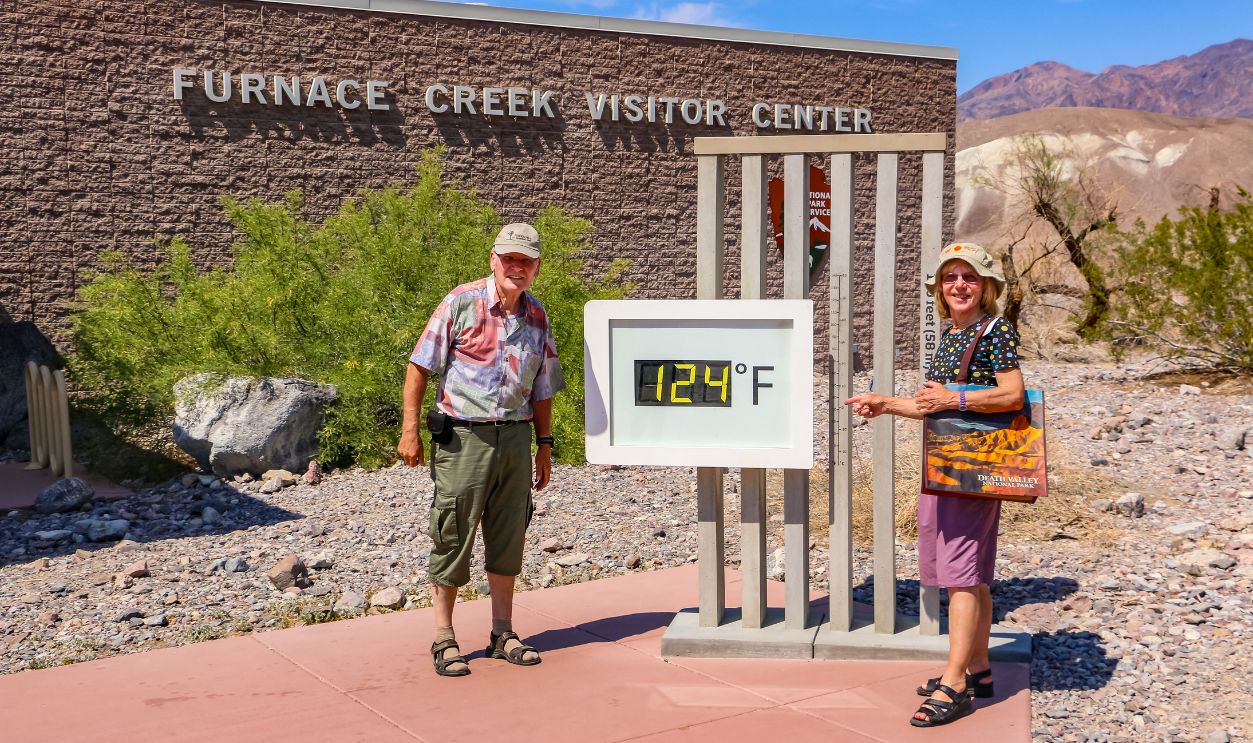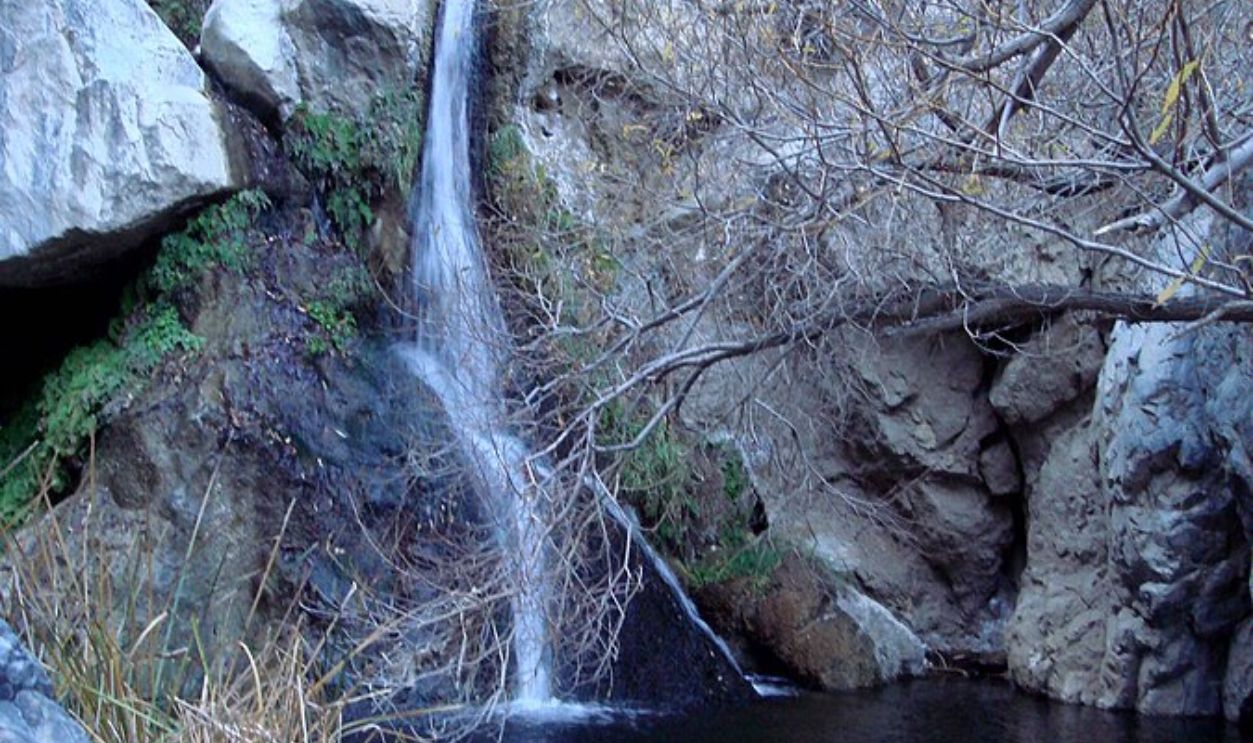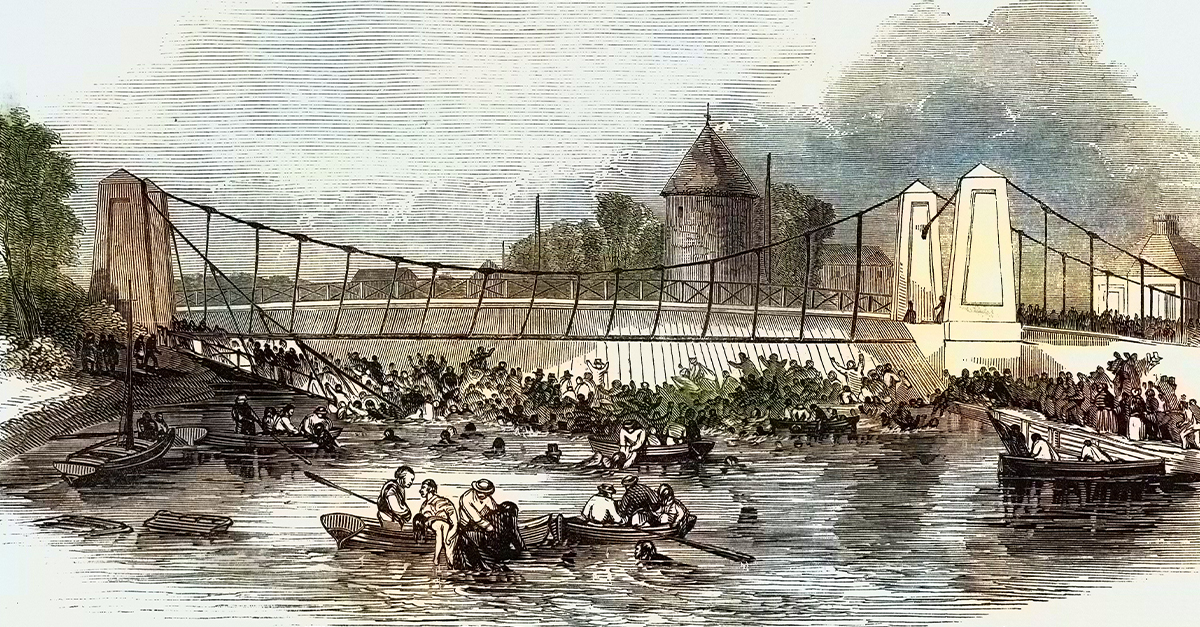Desert Inferno Facts
Have you ever wondered what it feels like to stand in the hottest place on Earth? At Furnace Creek in Death Valley, you will experience just that. This searing desert holds world temperature records and untold stories of survival.

Geographical Location
Furnace Creek is located in Death Valley National Park in Eastern California and is said to be 190 feet (58 meters) below sea level. It’s situated between the Amargosa Range to the east and the Panamint Range to the west.
 Ken Lund from Reno, Nevada, USA, CC BY-SA 2.0, Wikimedia Commons
Ken Lund from Reno, Nevada, USA, CC BY-SA 2.0, Wikimedia Commons
Geographical Location (Cont.)
This positioning creates a natural heat trap that contributes to the area’s extreme temperatures. It is often mistakenly referred to as being 282 feet below sea level, which is actually the depth of Badwater Basin, the lowest point in North America.
 Stan Shebs, CC BY-SA 3.0, Wikimedia Commons
Stan Shebs, CC BY-SA 3.0, Wikimedia Commons
Geological Formation
The valley’s formation is primarily attributed to tectonic forces that caused the Earth’s crust to stretch and fracture. This led to the development of normal faults, where blocks of the crust drop relative to others, creating the basin and range topography.
 logopop, CC BY-SA 3.0, Wikimedia Commons
logopop, CC BY-SA 3.0, Wikimedia Commons
Geological Formation (Cont.)
Over time, the valley has accumulated thousands of feet of sediment, primarily from erosion and weathering processes in the surrounding mountains. This sediment fill contributes to the geological features observed in Death Valley today.
 National Archives and Records Administration, Wikimedia Commons
National Archives and Records Administration, Wikimedia Commons
Historical Significance
It is said that, in December 1849, two groups of travelers, totaling around 100 wagons, entered Death Valley after straying from the Old Spanish Trail. They searched for a route to the goldfields but found themselves trapped in the harsh desert.
Historical Significance (Cont.)
This pivotal moment in history is marked by the experiences of the Bennett-Arcane Party. Upon leaving the valley, one member reportedly said, “Goodbye, Death Valley”. And therefore, the name “Death Valley” originated from this expedition.
 JERRYE AND ROY KLOTZ MD, CC BY-SA 3.0, Wikimedia Commons
JERRYE AND ROY KLOTZ MD, CC BY-SA 3.0, Wikimedia Commons
Historical Significance (Cont.)
However, before European-American discovery, the Death Valley area was inhabited by the Timbisha Shoshone tribe, who have lived in this unforgiving desert environment for over a thousand years. Apparently, they used mesquite beans for flour and pinon nuts as a food source.
Borax Discovery Era
The Harmony Borax Works, located near Furnace Creek in Death Valley, played a significant role in the mining history of the region from 1883 to 1888. According to sources, Borax deposits were discovered in 1881 by Aaron and Rosie Winters.
 GFred1, CC BY-SA 4.0, Wikimedia Commons
GFred1, CC BY-SA 4.0, Wikimedia Commons
Borax Discovery Era (Cont.)
Then, business associates William Tell Coleman and Francis Marion Smith acquired these claims, and this led to the establishment of the Harmony Borax Works in 1883. At its peak, the Harmony Borax Works employed about 40 men, and it produced three tons of borax daily.
 Paul Hermans, CC BY-SA 3.0, Wikimedia Commons
Paul Hermans, CC BY-SA 3.0, Wikimedia Commons
World’s Hottest Day
On July 10, 1913, Furnace Creek (then called Greenland Ranch) recorded a temperature of 134°F (56.7°C), establishing the highest verified air temperature on Earth. This record stands today, though some modern experts dispute its accuracy.
 LBM1948, CC BY-SA 4.0, Wikimedia Commons
LBM1948, CC BY-SA 4.0, Wikimedia Commons
Historic Temperature Record
The temperature was recorded during an unprecedented heatwave from July 7 to July 14, 1913, with several days reaching extreme highs. The observer at the time, Oscar Denton, noted maximum temperatures of 127°F, 128°F, 129°F, and finally 134°F.
Record Controversy
Christopher Burt, a weather historian, argues that meteorological conditions at the time make it “essentially not possible” for such high temperatures to have occurred without error. Issues arose related to the thermometer used, which was only graduated up to 135°F.
 logopop, CC BY-SA 3.0, Wikimedia Commons
logopop, CC BY-SA 3.0, Wikimedia Commons
Recent Temperature Record
Recently, July 2024 was noted as the hottest month on record for Death Valley National Park, with an average high of 121.9°F and a mean daily temperature of 108.5°F (42.5°C). It surpassed the previous record of 108.1°F (42.3°C) set in 2018.
 Sundry Photography, Shutterstock
Sundry Photography, Shutterstock
Summer Extremes
During the summer of 1996, Furnace Creek recorded 40 days with temperatures exceeding 120°F (49°C) and 105 days with temperatures over 110°F (43°C). This period exemplified the extreme heat that characterized the region.
 dconvertini, CC BY-SA 2.0, Wikimedia Commons
dconvertini, CC BY-SA 2.0, Wikimedia Commons
Summer Extremes (Cont.)
The summer of 1917 was even more remarkable, witnessing 52 days where temperatures reached 120°F or higher, including 43 consecutive days at or above this threshold. This record remains one of the longest stretches of extreme heat there.
 logopop, CC BY-SA 3.0, Wikimedia Commons
logopop, CC BY-SA 3.0, Wikimedia Commons
Ground Temperature
Scientists noted that the hottest temperature ever recorded on Earth happened at Furnace Creek, hitting a scorching 201.0°F (93.9°C) on July 15, 1972. It’s wild that this is still the only time anyone has documented a surface temperature over 200°F in all of history.
 RuggyBearLA, CC BY 2.0, Wikimedia Commons
RuggyBearLA, CC BY 2.0, Wikimedia Commons
Climate Classification
Furnace Creek has a hot desert climate, which means it heats up in the summer and gets a bit warm in the winter. It’s affected by its spot in Death Valley National Park, where four big mountain ranges keep moist air from the Pacific Ocean out.
 Vadim Manuylov, CC BY-SA 3.0, Wikimedia Commons
Vadim Manuylov, CC BY-SA 3.0, Wikimedia Commons
Climate Classification (Cont.)
This leads to very little rainfall. In fact, Furnace Creek receives rainfall averaging about 1.5 inches (38 mm) annually. The rain shadow effect formed by the surrounding mountain ranges significantly limits moisture availability, and this creates hyper-arid conditions.
 Vadim Manuylov, CC BY-SA 3.0, Wikimedia Commons
Vadim Manuylov, CC BY-SA 3.0, Wikimedia Commons
Desert Blooms
The jolly thing about Spring rains in Death Valley is that they can trigger spectacular wildflower blooms. For example, the massive rainfall during the 2004-2005 season created ephemeral lakes and provided the necessary moisture for dormant seeds to germinate.
 National Park Service, Wikimedia Commons
National Park Service, Wikimedia Commons
Overnight Temperatures
Summer nights in Furnace Creek provide minimal relief from the intense daytime heat. The highest overnight temperature recorded was 107°F (42°C) on July 12, 2012. This day also achieved the world’s warmest 24-hour mean temperature of 117.5°F (47.5°C).
 Wilson Ye wilsonye123, CC0, Wikimedia Commons
Wilson Ye wilsonye123, CC0, Wikimedia Commons
Winter Conditions
Winter temps here are pretty mild, hardly ever dropping below freezing. The coldest it’s ever gotten was 15°F (-9°C) back in January 1913. As for snow, we’ve only seen any real accumulation once, way back in January 1922.
 Daniel Mayer at en.wikipedia, CC BY-SA 3.0, Wikimedia Commons
Daniel Mayer at en.wikipedia, CC BY-SA 3.0, Wikimedia Commons
Winter Conditions (Cont.)
During the winter months, daytime temperatures in Furnace Creek typically range from the mid-60s to low 70s Fahrenheit (approximately 18°C to 22°C). Nighttime temperatures can drop significantly but usually remain above freezing.
 Carol M. Highsmith, Wikimedia Commons
Carol M. Highsmith, Wikimedia Commons
Ancient Lake
Lake Manly was formed due to climatic changes during the Pleistocene, mainly due to glacial melt from the Sierra Nevada. The lake was part of a pluvial lake inundating several basins across the desert.
 National Park Service, Wikimedia Commons
National Park Service, Wikimedia Commons
Ancient Lake (Cont.)
This created a significant body of water that could overflow into adjacent valleys. Lake Manly dried up approximately 10,000 years ago, and it left extensive salt flats and pans. This includes those visible in areas like Badwater Basin.
 Joe Parks from Berkeley, CA, CC BY 2.0, Wikimedia Commons
Joe Parks from Berkeley, CA, CC BY 2.0, Wikimedia Commons
Ancient Lake (Cont.)
When the lake’s water dried up, it left behind a bunch of salt, which created polygon patterns you see in Death Valley. The remnants of Lake Manly are evidenced by shorelines, terraces, and sediment deposits found throughout this famous area.
 Mark A. Wilson, CC0, Wikimedia Commons
Mark A. Wilson, CC0, Wikimedia Commons
Devil’s Golf Course
In areas like Devil’s Golf Course, where the salt pan is above flood level, water from underlying mud rises through capillary action. This water quickly evaporates due to high temperatures, and it leaves behind a salty residue that contributes to the growth of salt formations.
 Nick Eskelinen, CC BY-SA 1.0, Wikimedia Commons
Nick Eskelinen, CC BY-SA 1.0, Wikimedia Commons
Native Wildlife
The valley supports diverse wildlife, which includes bighorn sheep, coyotes, kit foxes, and bobcats. Specialized rodents like kangaroo rats and antelope ground squirrels have allegedly adapted to survive such extreme desert conditions.
Native Wildlife (Cont.)
Kit Foxes are often found at lower elevations and rely on their keen senses to hunt small rodents and insects. Bighorn sheep are recognized for their agility and can often be spotted in canyons and on rocky slopes.
 Larry Lamsa, CC BY 2.0, Wikimedia Commons
Larry Lamsa, CC BY 2.0, Wikimedia Commons
Native Wildlife (Cont.)
Besides, the park is home to many reptiles, such as sidewinder rattlesnakes and chuckwallas, which find shelter under rocks during the day’s heat. Many species are nocturnal, which lets them avoid daytime temperatures that can exceed 120°F (49°C).
Plant Adaptations
Vegetation in this place varies based on elevation and salt content. For instance, salt-tolerant pickleweed and salt grass surround springs, while creosote bush dominates gravel fans. Similarly, desert holly (Atriplex hymenelytra) survives in lower elevations.
 Manfred Werner, CC BY-SA 3.0, Wikimedia Commons
Manfred Werner, CC BY-SA 3.0, Wikimedia Commons
Plant Adaptations (Cont.)
Many types of cacti are abundant in the northern parts of Death Valley. The saguaro cactus, cholla, and barrel cactus are examples of plants adapted to store water and withstand extreme heat. Joshua trees can also be found at the fringes over here.
 Bernard Gagnon, CC BY-SA 3.0, Wikimedia Commons
Bernard Gagnon, CC BY-SA 3.0, Wikimedia Commons
Avian Inhabitants
The present Death Valley bird census is diverse, with estimates indicating that approximately 349 species live here. This includes migratory and year-round residents who may visit the area year-round. Ravens are commonly seen throughout the park.
 Speednat, CC BY-SA 3.0, Wikimedia Commons
Speednat, CC BY-SA 3.0, Wikimedia Commons
Avian Inhabitants (Cont.)
Roadrunners are also frequently spotted darting across. Also, the Tundra Swan species, typically found in western marshes during winter, was spotted at Furnace Creek Wash and other locations within the park. The Peregrine Falcon has also been spotted.
 Wilson44691, Wikimedia Commons
Wilson44691, Wikimedia Commons
Water Sources
The Amargosa River pumps underground water into the southern part of the valley. It is fed by groundwater from the surrounding mountains. Up north, Salt Creek only has a little bit of surface flow, and you’ll also find springs and marshes scattered around the salt flats.
 Stan Shebs, CC BY-SA 3.0, Wikimedia Commons
Stan Shebs, CC BY-SA 3.0, Wikimedia Commons
Death Valley Springs
Notable springs in Death Valley, such as Cow Creek, Texas Springs, and Mesquite Springs, provide essential water sources for wildlife and human visitors. Cow Creek provides the endangered Death Valley pupfish, which rely on its waters for survival.
 Bureau of Land Management Oregon and Washington from Portland, America, Wikimedia Commons
Bureau of Land Management Oregon and Washington from Portland, America, Wikimedia Commons
Virga Formation
When precipitation does occur in the form of rain or snow, it often evaporates before reaching the ground due to the high temperatures and low humidity levels typical of the desert environment. This phenomenon is known as virga.
 John Robert McPherson, CC BY-SA 4.0, Wikimedia Commons
John Robert McPherson, CC BY-SA 4.0, Wikimedia Commons
Wind Effects
Warm mountain winds, known as foehn winds, significantly contribute to the extreme temperatures experienced in Death Valley. Foehn winds can typically raise temperatures by as much as 14 °C (25 °F) in just a matter of hours.
 Ilka Franz, CC BY-SA 4.0, Wikimedia Commons
Ilka Franz, CC BY-SA 4.0, Wikimedia Commons
Annual Festivals
Death Valley National Park hosts a variety of annual festivals as well. One such festival is the Death Valley Dark Sky Festival. It celebrates the park’s night skies with opportunities for stargazing, astronomy talks, and astrophotography workshops.
 NASA's, USA, CC BY 2.0, Wikimedia Commons
NASA's, USA, CC BY 2.0, Wikimedia Commons
Annual Festivals (Cont.)
The event even holds lectures from experts at NASA and other institutions. Due to Death Valley’s designation as a Gold Tier Dark Sky Park, visitors can enjoy views of stars, planets, and galaxies. The festival is typically held in November.
 The Oasis at Death Valley Night Skies by The Oasis at Death Valley
The Oasis at Death Valley Night Skies by The Oasis at Death Valley
Managing Non-Native Species
One of the biggest challenges faced by Death Valley is the presence of non-native species like tamarisk or salt cedar. These invasive trees can outcompete native vegetation for resources, altering habitats and reducing biodiversity.
 Krzysztof Ziarnek, Kenraiz, CC BY-SA 4.0, Wikimedia Commons
Krzysztof Ziarnek, Kenraiz, CC BY-SA 4.0, Wikimedia Commons
Removal Efforts
Park management has initiated programs to remove tamarisk trees and restore native plant communities. This includes mechanical removal and targeted herbicide application aimed at reducing their spread and promoting the recovery of indigenous flora.
 Cheima fezzani, CC BY-SA 4.0, Wikimedia Commons
Cheima fezzani, CC BY-SA 4.0, Wikimedia Commons
Darwin Falls
Darwin Falls is a grand waterfall on the western corner of Death Valley National Park, near the settlement of Panamint Springs, California. It is around 18 feet (5.5 m) tall and is one of the few year-round waterfalls in the region.
 Bobak Ha'Eri, CC BY-SA 2.5, Wikimedia Commons
Bobak Ha'Eri, CC BY-SA 2.5, Wikimedia Commons
Popular Culture
Death Valley National Park has served as a backdrop for numerous films and television shows over the years. Apparently, Star Wars: Episode IV and Star Wars: Episode VI featured scenes shot at the Mesquite Flat Sand Dunes and areas around Furnace Creek.
 Twentieth Century, Star Wars: Episode IV – A New Hope (1977)
Twentieth Century, Star Wars: Episode IV – A New Hope (1977)
Tourist Season
Winter is considered the best time to visit Death Valley, with daytime temperatures typically ranging from the 70s°F (20-25°C). This allows for comfortable hiking and exploration without the extreme heat that characterizes the summer months.













